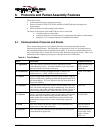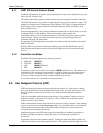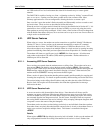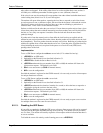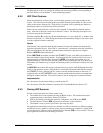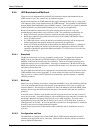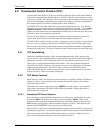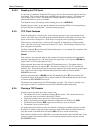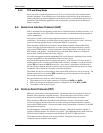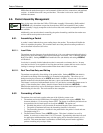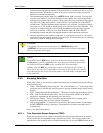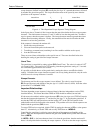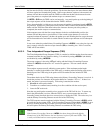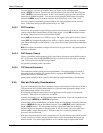
User’s Guide Protocols and Packet Assembly Features
2110212 Rev 1.0 Page 45
6.3.5. TCP and Sleep Mode
Due to the positive acknowledgements used in TCP, use of sleep modes in the modem must be
carefully considered. If the modem goes to sleep during an open session, the possible delays in
sending and picking up acknowledgements can result in excessive re-transmissions and even lost
connections. Most telemetry applications will not experience a problem, however attention to
timing is required.
6.4. Serial Line Interface Protocol (SLIP)
SLIP is one method for encapsulating packet data over dedicated and/or switched serial lines. It is
a useful and reliable way to allow mixes of hosts and routers to communicate with one another in
various combinations.
This protocol is useful if the local host application must have multiple sessions active
concurrently. The modem’s own PAD modes can only support one session at a time. If the host
system can manage multiple sessions (sockets) then SLIP is a good choice.
When operating in SLIP mode, the modem’s internal Packet Assembly / Disassembly (PAD)
services are bypassed and the modem acts as a router passing data between the host’s protocol
stack, and the CDPD network. All protocol headers are the responsibility of the host as is the
SLIP framing of the packets. The modem will parse the SLIP frame character to distinguish
packets and to identify the data state escape sequence.
All session management including handshaking TCP session requests, originating client sessions,
and processing PINGs are the responsibility of the local host system.
Note that the SLIP protocol does not support auto-answer. If the modem was in auto-answer in
another packet service, it will be ignored when SLIP is selected. Attempts to set the auto-answer
register (S0) will return the ERROR result code. Auto-answer is meaningless in SLIP mode as
the data coming in from the network is passed to the local host and the host can choose to accept
(answer) the call or decline the connection (or discard the packet).
The modem does not have a direct entry to data state in SLIP mode from a reset or power-up. The
modem requires the host to send the ATO command to go on-line (open the session) when the
host is ready to send and receive traffic.
Data state remains active until one of the following events:
• The modem receives the escape sequence as a SLIP frame (0xC0 +++ 0xC0)
• DTR is de-asserted, presuming the modem is configured to use DTR (&D1 or &D2).
• The modem is reset or power-cycled
6.5. Point-to-Point Protocol (PPP)
PPP offers a more robust connection than SLIP. The modem and its host negotiate a variety of
elements of the connection using PPP messages. The modem advises the local host of what
features are available and the host enables or disables the available features as needed.
When operating in PPP mode, the modem’s internal Packet Assembly / Disassembly (PAD)
services are bypassed and the modem acts as a router passing data between the host’s protocol
stack, and the CDPD network. All protocol headers are the responsibility of the host as is the PPP
management of the packets.
The implementation in the DART 300 modem is minimal. Although the modem is capable of
replying to PPP negotiations, few features are available. The implementation has been tested and
will successfully establish a connection under Windows (95, 98, NT, 2000) and Linux.
The modem can advise the host of the current IP (NEI). Encrypted passwords and data
compression are not available in the modem.



